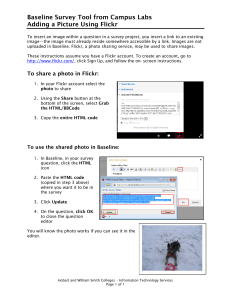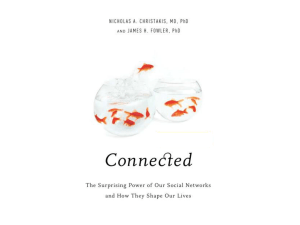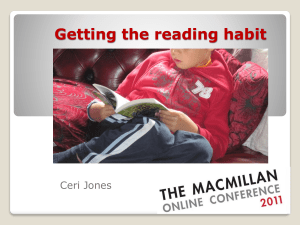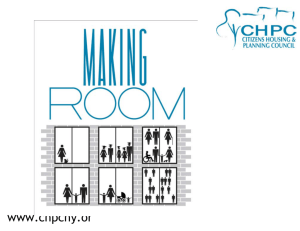Organizing Your Online Course
advertisement
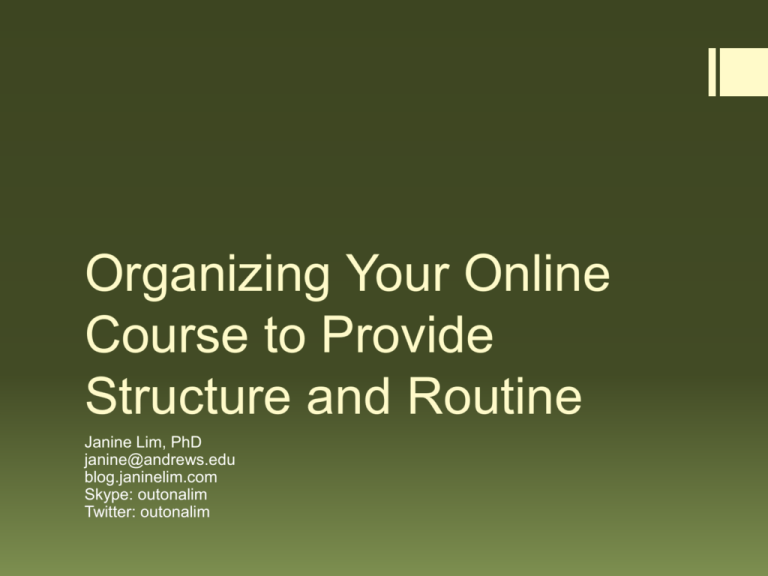
Organizing Your Online Course to Provide Structure and Routine Janine Lim, PhD janine@andrews.edu blog.janinelim.com Skype: outonalim Twitter: outonalim A little about me… blog.janinelim.com Definitions Self-Paced Open Enrollment Correspondence Online, DVD, Print-based Register anytime Set your own pace to finish Interactive Online: Asynchronous Online Interactive discussion boards Weekly or daily paced No live meetings Interactive Online: Synchronous Online Weekly or daily paced Live meetings: GoTo Meeting, Adobe Connect, videoconferencing Data obtained from surveys of students enrolled in asynchronous (completely online) courses offered by the State University of New York indicate that three factors “contribute significantly to the success of asynchronous online courses. These factors are a course structure that is both clear and consistent, an instructor that interacts frequently and productively with students, and a constructive and dynamic discussion between students and their peers.” Swan, K. (2001). Virtual interaction: Design factors affecting student satisfaction and perceived learning in asynchronous online courses.Distance Education, 22(2), 306-331. Researchers at the University of British Columbia who evaluated 127 courses offered online “have concluded that appearance and structure can make or break an online course.” McCollum, K. (1998). Researchers pick best and worst web courses. The Chronicle of Higher Education, 44, A29. Flickr image by libertygrace Flickr image by ecastro Flickr image by woodleywonderworks Flickr image by cdsessums select a course Content Flickr image by hashmil Flickr image by Chicago Art Department Communication & Interaction Assessment Microsoft Clip Art Flickr image by hashmil web pages, resources, video clips, etc. Structuring Content Chunking Your Content How many weeks long is your course? What are the topics you will cover? How many modules for each topic? What are the critical components for each module? How many credit hours need to be included? Readings Discussion Journal Experiments Simulation Group work Modeling Assessment Quizzes Test Activities Problems Research Examples define course components Application Papers Portfolio Projects Lectures Lecture notes Case studies construct your content pattern get creative Flickr image by Chicago Art Department weekly emails, interactive discussion, phone calls, expectations Structuring Communication and Interaction Data obtained from surveys of students enrolled in asynchronous (completely online) courses offered by the State University of New York indicate that three factors “contribute significantly to the success of asynchronous online courses. These factors are a course structure that is both clear and consistent, an instructor that interacts frequently and productively with students, and a constructive and dynamic discussion between students and their peers.” Swan, K. (2001). Virtual interaction: Design factors affecting student satisfaction and perceived learning in asynchronous online courses.Distance Education, 22(2), 306-331. Week 1: Hover! Initial Communication Welcome each student. Pique their interest. How to contact & get help. Ice breaker or introductory activity. Write in “oral” language. Check email and discussion often. Share stories and personal information. Standard Discussion Spaces Weekly Emails Intro to upcoming topic Suggested schedule How to get help Status on grading Address any issues from feedback surveys or student emails Well-formatted, easy to read, and warm and friendly Schedule Teaching Time Set aside a regular time twice a day to check in on your students. Answer all course related emails. Set aside a regular time at least once a day to check in on the discussion board. Skim through for comments that you need to post to. Post at least as often as you require students to post. They need to know that you are "there" as much as you need to know that they are "there." Dialogue "is a living experience of inquiry within and between people. It is "a conversation with a center, not sides. It is a way of taking the energy of our differences and channeling it toward something that has never been created before." It is a "flow of meaning." Dialogue is "about evoking insight, which is a way of reordering our knowledge--particularly the taken-for-granted assumptions that people bring to the table." Isaacs, William. (1999). Dialogue and the art of thinking together. New York: Currency. p. 9, 19, & 45 Ask questions that lead to higher level thinking: I wonder... Why... Do you think...? Ask real questions. Don't ask questions that have one or two word answers. Don't ask rhetorical or sarcastic questions. Learning to ask divergent questions as well as convergent ones will increase the level of thinking and learning. For example, divergent questions are: productive in contrast to reproductive (students are asked to produce rather than reproduce). e.g. List different ways to “see” without using the eyes. Or list occupations that require eyesight. comparing and contrasting (moving from concrete to abstract ideas) e.g. Compare/contrast books and lectures. How is building a building similar to/different from building a relationship? Freed, S. & Lim, J. 2001. From posting to dialogue in 10 easy steps. http://www.avln.org/learning/aot/dialogue.htm Future Thinking Questions Don Tapscott has made some predictions about what the workplace of the future will be like. What about your workplace? Be creative and imagine what your classroom will look like in 5, 10, or 15 years from now. Thinking back to last week's question, will you still be needed? Sharing Feelings and Opinions Respond to one or both of these questions. Do you agree with the description of your generation? What about the others described? Do your experiences challenge or confirm the description? How do you think online interaction affects kids? How has it affected you? (experience) "Is this a generation of children who are beginning to process information and reason differently than the rest of us?" p. 102 Growing Up Digital Personal Experience After reading chapter one, share an experience you've had with the "Net Generation". Do your experiences confirm what you read or challenge what you read? From this week's introduction page quote, what technology may as well be magic to you? Why or in what ways? (This class had a weekly technology quote posted on the assignments page. The quote mentioned was: "Any sufficiently advanced technology is indistinguishable from magic." -Arthur C. Clarke) Have you ever purchased anything online? What was it? What was your experience like? Would you do it again? If you haven't, then why? generate a discussion question Instructor Discussion Participation Refer to concepts presented in the course and help lead to new ideas and help learners see other relationships. Be visible daily in the discussion. Always ask extension questions, encourage critical thinking, and invite learners to think at a deeper level. Create posts which reflect answers showing a good balance between critical thought and questioning. Posts present a friendly, encouraging environment for learners. Posts use humor, personal experiences, and helpful attitudes. Posts demonstrate respect for the learners and demonstrate an appropriate tone toward learners. Assignments and Homework plan your interaction and communication Microsoft Clip Art weekly emails, Structuring Assessment Quick Feedback If applicable, use the built-in grade book in your course software and post the grades there at least once a week. Use the quizzing feature of your software to create graded or ungraded self-tests using the multiple choice or T/F feature so that it is automatically graded. Release the scores to students as soon as they finish the quiz. Personalized Progress Reports Use email or your course software's mail tool to send personalized updates and progress reports to students. This helps them feel connected to the class/instructor and helps to keep them on task. plan the structure of assessment Content Flickr image by hashmil Flickr image by Chicago Art Department Communication & Interaction Assessment Microsoft Clip Art Questions? Janine Lim, PhD janine@andrews.edu blog.janinelim.com Skype: outonalim Twitter: outonalim Sources: AVLN classes: Active Online Teaching and Active Online Courses; Classroom Connect online course resources

